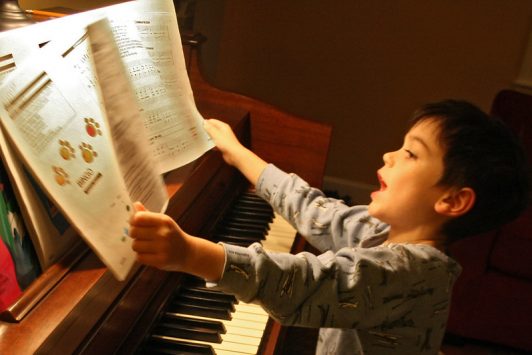We already know why we need to teach lead sheet skills to our students. But when is the earliest our students can get started with lead sheets? Do we need to wait until they’re at an intermediate level and capable of making full arrangements?

I don’t think so.
I believe in the value of lead sheets for even our youngest absolute beginner piano students.
No, it shouldn’t be a huge part of their curriculum, but a little foray into lead sheets once a year can provide rewards in the long-run. Let me help you get your students started with lead sheets even if they’re right at the beginning of their musical journey.
Using Lead Sheets with Absolute Beginners of All Ages
When we’re working with piano lead sheets (or any chord-based playing,) it’s important to take hand span and dexterity into the equation. So, I’ll split my approach up by age here so you can see how it differs based on these factors.
Psst…Want something more in-depth? Grab the 6-week Lead Sheet Kickoff course in the Vibrant Music Teaching library for step-by-step lesson plans. Not a VMT member? Visit the membership page to learn more about all the great resources available for members.
Introducing Lead Sheets to Young Beginners
For my youngest beginner students, I teach lead sheet skills by getting them to play just the root note of the chord in the bass while I play the melody and we both sing along. That way, they only have to look at the chord symbols (they just think of them as note names) but they’re still getting accustomed to the look of a lead sheet early on in their studies.

This is also their first introduction to accompanying. Yes, it’s a very basic version of an accompaniment, but it still counts! Playing as part of a team is an important skill and this is a valuable experience for them as they have to listen, sing and play at the same time.
Introducing Lead Sheets to Teen Beginners
Teenagers (and preteens with particularly good dexterity) might be able to handle fuller chords right off-the-bat. Experiment with each of these options for their accompaniment while you play and sing the melody:
- One handed chords
- Root notes in both hands
- Root notes in left while right plays chords, open fifths or thirds
Don’t rush your newbie students towards the full chords. If it’s even a little bit awkward, it won’t be fun for them when they start moving around and they won’t be able to play with rhythm patterns because they’ll be so focused on their fingers.
Introducing Lead Sheets to Adult Beginners
Why am I separating the adults from the teens? Because many adult beginners will struggle a lot more with the coordination than the teenagers will. This is especially true if they are absolute beginners who have never touched a piano or learnt another instrument before taking lessons with you.

The adult students are also going to be less likely to be comfortable singing with you, and you may not want to push them on it if they are.
For these reasons, I suggest starting your adult students with the root-only version of the lead sheet where you play the melody, and then slowly scaffolding the learning from there. Make sure that every stage feels easy-as-pie before you add a layer of difficulty. Adult students are very prone to negative self-talk and frustrations at the technical side of piano playing!
Taking Lead Sheets Further
As your students progress there’s so much more scope for arranging and getting creative with lead sheets (such as these ideas about chords on my music theory page), but it’s the first step that I find many teachers struggle to teach. Does that ring true for you?
Let me know in the comments below if this has been useful for you, or if you have a different way to use lead sheets with absolute beginners.

Do you have any examples of music to use with the beginners for lead sheets?
Elaine you can find free lead sheets at http://www.music-for-music-teachers.com for all levels.